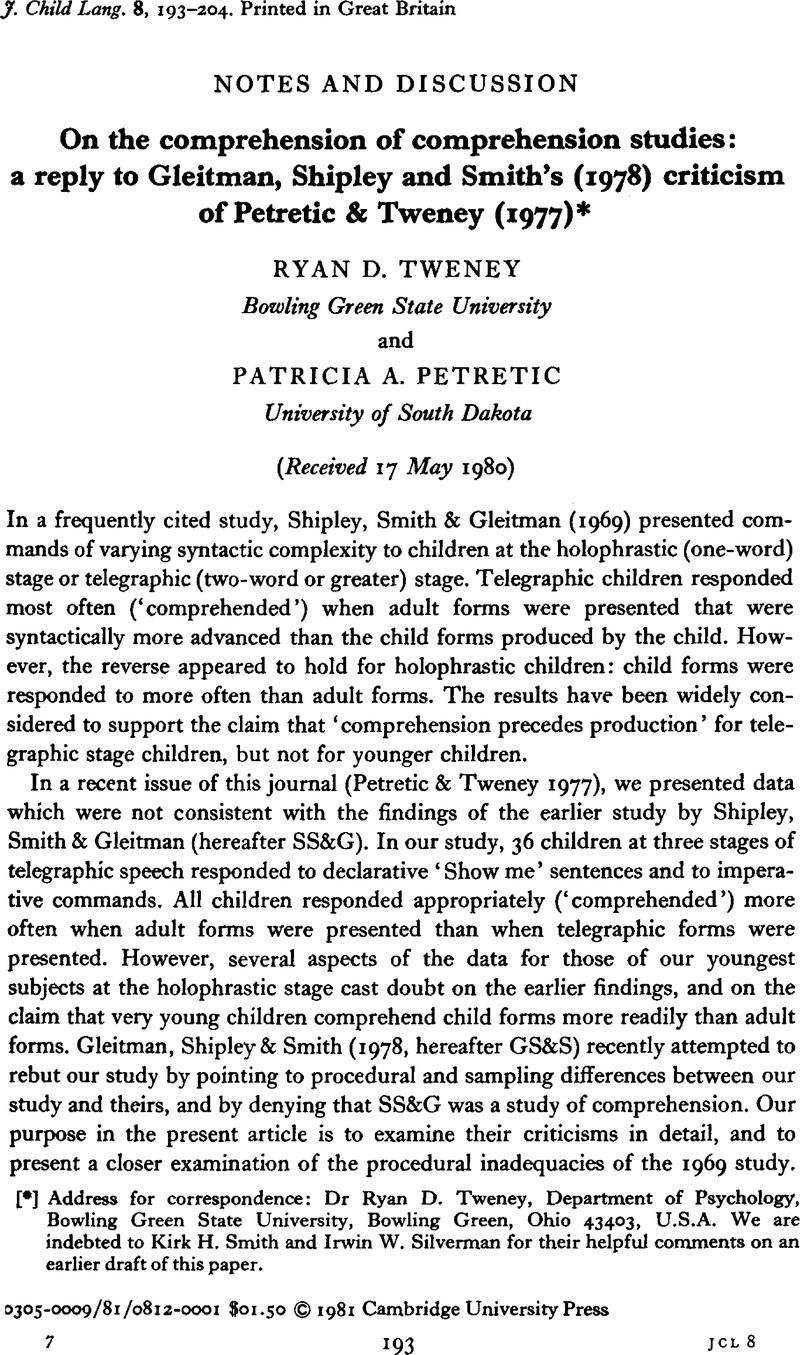No CrossRef data available.
Article contents
On the comprehension of comprehension studies: a reply to Gleitman, Shipley and Smith's (1978) criticism of Petretic & Tweney (1977)*
Published online by Cambridge University Press: 26 September 2008
Abstract
An abstract is not available for this content so a preview has been provided. Please use the Get access link above for information on how to access this content.

Information
- Type
- Notes and dicussion
- Information
- Copyright
- Copyright © Cambridge University Press 1981
Footnotes
[*]
Address for correspondence: Dr Ryan D. Tweney, Department of Psychology, Bowling Green State University, Bowling Green, Ohio 43403, U.S.A. We are indebted to Kirk H. Smith and Irwin W. Silverman for their helpful comments on an earlier draft of this paper.
References
REFERENCES
Baird, R. (1972). On the role of chance in imitation-comprehension-production test results. JVLVB 11. 474–7.CrossRefGoogle Scholar
Bloom, L. (1974). Talking, understanding, and thinking. In Schiefelbusch, R. L. & Lloyd, L. L. (eds), Language perspectives–acquisition, retardation and intervention. Baltimore: University Park Press.Google Scholar
Bowerman, M. (1973). Early syntactic development: a cross-linguistic study with special reference to Finnish. Cambridge: C.U.P.Google Scholar
Braine, M. D. S. (1963). The ontogeny of English phrase structure: the first phase. Lg 39. 1–13.Google Scholar
Chapman, R. (1974). Developmental relationship between receptive and expressive language. Discussion summary. In Schiefelbusch, R. L. & Lloyd, L. L. (eds), Language perspectives-acquisition, retardation, and intervention. Baltimore: University Park Press.Google Scholar
De Villiers, P. A. & De Villiers, J. G. (1972). Early judgments of semantic and syntactic acceptability by children. JPsycholingRes 1. 299–310.Google ScholarPubMed
Fernald, C. D. (1972). Control of grammar in imitation, comprehension and production: problems in replication. JVLVB 11. 606–13.CrossRefGoogle Scholar
Fraser, C., Bellugi, U. & Brown, R. (1963). Control of grammar in imitation, comprehension, and production. JVLVB 2. 121–35.CrossRefGoogle Scholar
Gleitman, L. R., Shipley, E. F. & Smith, C. (1978). Old and new ways not to study comprehension: comments on Petretic & Tweney's (1977) experimental review of Shipley, Smith & Gleitman (1969). JChLang 5. 501–19.Google Scholar
Golinkoff, R. M. & Markessini, J. (1980). ‘Mommy sock’: the child's understanding of possession as expressed in two-noun phrases. JChLang 7. 119–35.Google ScholarPubMed
Ingram, D. (1974). The relationship between comprehension and production. In Schiefelbusch, R. L. & Lloyd, L. L. (eds), Language perspectives-acquisition, retardation, and intervention. Baltimore: University Park Press.Google Scholar
Lykken, D. T. (1968). Statistical significance in psychological research. PsychRev 70. 151–9.Google ScholarPubMed
McCall, R. B. (1970). The use of multivariate procedures in developmental psychology. In Mussen, P. H. (ed.), Carmichael's manual of child psychology. New York: Wiley.Google Scholar
McNeill, D. (1970). The acquisition of language: the study of developmental psycholinguistics. New York: Harper & Row.Google Scholar
Meehl, P. E. (1978). Theoretical risks and tabular asterisks: Sir Karl, Sir Ronald and the slow progress of soft psychology. JConsClinPsychol 46. 806–34.Google Scholar
Nelson, K. (1973). Structure and strategy in learning to talk. Monogr. Soc. Res. Ch. Dev. 38 (No. 149).Google Scholar
Petretic, P. A. & Tweney, R. D. (1977). Does comprehension precede production ? The development of children's responses to telegraphic sentences of varying grammatical adequacy. JChLang 4. 201–9.Google Scholar
Ruder, K. F., Smith, M. D. & Murai, H. M. (1980). Response to commands revisited again. JChLang 7. 197–205.Google Scholar
Sachs, J. & Truswell, L. (1978). Comprehension of two-word instructions by children in the one-word stage. JChLang 5. 17–24.Google Scholar
Shipley, E. F., Smith, C. S. & Gleitman, L. R. (1969). A study in the acquisition of language: free responses to commands. Lg 45. 322–43.Google Scholar
Siegel, S. (1956). Nonparametric statistics for the behavioral sciences. New York: McGraw-Hill.Google Scholar
Smith, C. (1970). An experimental approach to children's linguistic competence. In Hayes, J. R. (ed.), Cognition and the development of language. New York: Wiley.Google Scholar
Tatsuoka, M. M. (1971). Multivariate analysis: techniques for educational and psychological research. New York: Wiley.Google Scholar
Tversky, A. & Kahneman, D. (1971). Belief in the law of small numbers. PsycholBull 76. 105–10.Google Scholar

